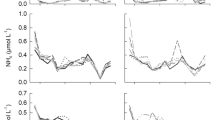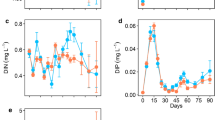Abstract
Indoor mesocosm experiments were conducted to test for potential climate change effects on the spring succession of Baltic Sea plankton. Two different temperature (Δ0 °C and Δ6 °C) and three light scenarios (62, 57 and 49 % of the natural surface light intensity on sunny days), mimicking increasing cloudiness as predicted for warmer winters in the Baltic Sea region, were simulated. By combining experimental and modeling approaches, we were able to test for a potential dietary mismatch between phytoplankton and zooplankton. Two general predator–prey models, one representing the community as a tri-trophic food chain and one as a 5-guild food web were applied to test for the consequences of different temperature sensitivities of heterotrophic components of the plankton. During the experiments, we observed reduced time-lags between the peaks of phytoplankton and protozoan biomass in response to warming. Microzooplankton peak biomass was reached by 2.5 day °C−1 earlier and occurred almost synchronously with biomass peaks of phytoplankton in the warm mesocosms (Δ6 °C). The peak magnitudes of microzooplankton biomass remained unaffected by temperature, and growth rates of microzooplankton were higher at Δ6 °C (μ∆0 °C = 0.12 day−1 and μ∆6 °C = 0.25 day−1). Furthermore, warming induced a shift in microzooplankton phenology leading to a faster species turnover and a shorter window of microzooplankton occurrence. Moderate differences in the light levels had no significant effect on the time-lags between autotrophic and heterotrophic biomass and on the timing, biomass maxima and growth rate of microzooplankton biomass. Both models predicted reduced time-lags between the biomass peaks of phytoplankton and its predators (both microzooplankton and copepods) with warming. The reduction of time-lags increased with increasing Q10 values of copepods and protozoans in the tritrophic food chain. Indirect trophic effects modified this pattern in the 5-guild food web. Our study shows that instead of a mismatch, warming might lead to a stronger match between protist grazers and their prey altering in turn the transfer of matter and energy toward higher trophic levels.







Similar content being viewed by others
References
Aberle N, Lengfellner K, Sommer U (2007) Spring bloom succession, grazing impact and herbivore selectivity of ciliate communities in response to winter warming. Oecologia 150:668–681
Berger SA, Diehl S, Stibor H, Trommer G, Ruhenstroth M (2010) Water temperature and stratification depth independently shift cardinal events during plankton spring succession. Global Change Biol 16:1954–1965
Brock TD (1981) Calculating solar radiation for ecological studies. Ecol Modell 14:1–19
Brown JH, Gillooly JF, Allen AP, Savage VM, West GB (2004) Toward a metabolic theory of ecology. Ecology 85:1771–1789
Calbet A (2008) The trophic roles of microzooplankton in marine systems. ICES J Mar Sci 65:325–331
Castellani C, Irigoien X, Harris RP, Lampitt RS (2005) Feeding and egg production of Oithona similis in the North Atlantic. Mar Ecol Prog Ser 288:173–182
Christaki U, Dolan JR, Pelegri S, Rassoulzadegan F (1998) Consumption of picoplankton-size particles by marine ciliates: effects of physiological state of the ciliate and particle quality. Limnol Oceanogr 43:458–464
Davis CS (1984) Predatory control of copepod seasonal cycles on Georges Bank. Mar Biol 82:31–40
Diehl S, Berger S, Ptacnik R, Wild A (2002) Phytoplankton, light, and nutrients in a gradient of mixing depths: field experiments. Ecology 83:399–411
Durant JM, Hjermann DO, Ottersen G, Stenseth NC (2007) Climate and the match or mismatch between predator requirements and resource availability. Clim Res 33:271–283
Edwards M, Richardson AJ (2004) Impact of climate change on marine pelagic phenology and trophic mismatch. Nature 430:881–884
Foissner W, Berger H, Kohmann F (1991, 1992, 1994, 1995) Taxonomische und ökologische revision der Ciliaten des Saprobiensystems Band I–IV, vol, Informationsberichte Bayerisches Landesamt für Wasserwirtschaft, München
Gaedke U, Rubenstroth-Bauer M, Wiegand I, Tirok K, Aberle N, Breithaupt P, Lengfellner K, Wohlers J, Sommer U (2010) Biotic interactions may overrule direct climate effects on spring phytoplankton dynamics. Global Change Biology 16:1122–1136
Hillebrand H, Duerselen C-D, Kirschtel D, Pollingher U, Zohary T (1999) Biovolume calculation for pelagic and benthic microalgae. J Phycol 35:403–424
Hillebrand H, Burgmer T, Biermann E (2011) Running to stand still: temperature effects on species richness, species turnover, and functional community dynamics. Mar Biol. doi:10.1007/s00227-011-1827-z
IPCC (2007) Climate change 2007: the physical science basis. Contribution of working group I to the fourth assessment report of the intergovernmental panel on climate change. Cambridge
Irigoien X, Flynn KJ, Harris RP (2005) Phytoplankton blooms: a ‘loophole’ in microzooplankton grazing impact? J Plankton Res 27:313–321
Isla JA, Lengfellner K, Sommer U (2008) Physiological response of the copepod Pseudocalanus sp in the Baltic Sea at different thermal scenarios. Global Change Biol 14:895–906
Johansson M, Gorokhova E, Larsson U (2004) Annual variability in ciliate community structure, potential prey and predators in the open northern Baltic Sea proper. J Plankton Res 26:67–80
Jonsson PR (1986) Particle size selection, feeding rates and growth dynamics of marine planktonic oligotrichous ciliates (Ciliophora: Oligotrichina). Mar Ecol Prog Ser 33:265–277
Kahl A (1932) Urtiere oder Protozoa I. Wimpertiere oder Ciliata (Infusoria). In: Dahl F (ed) Tierwelt Deutschlands und der angrenzenden Meeresteile, vol 18, pp 1–886
Keller AA, Oviatt CA, Walker HA, Hawk JD (1999) Predicted impacts of elevated temperature on the magnitude of the winter-spring phytoplankton bloom in temperate coastal waters: a mesocosm study. Limnol Oceanogr 44:344–356
Landry MR (1983) The development of marine calanoid copepods with comment on the isochronal rule. Limnol Oceanogr 28:614–624
Landry MR, Calbet A (2004) Microzooplankton production in the oceans. ICES J Mar Sci 61:501–507
Lasker R (1981) The role of a stable ocean in larval fish survival and subsequent recruitment. In: Lasker R (ed) Marine fish larvae. University of Washington press, Seattle, pp 80–88
Leandro SM, Tiselius P, Queiroga H (2006) Growth and development of nauplii and copepodites of the estuarine copepod Acartia tonsa from southern Europe (Ria de Aveiro, Portugal) under saturating food conditions. Mar Biol 150:121–129
Lewandowska A, Sommer U (2010) Climate change and the spring bloom: a mesocosm study on the influence of light and temperature on phytoplankton and mesozooplankton. Mar Ecol Prog Ser 405:101–111
Loeder M, Meunier C, Wiltshire KH, Boersma M, Aberle N (2011) The role of ciliates, heterotrophic dinoflagellates and copepods in structuring spring phytoplankton communities at Helgoland Roads, North Sea. Mar Biol 158(7):1551–1580
Lopez-Urrutia A (2008) The metabolic theory of ecology and algal bloom formation. Limnol Oceanogr 53:2046–2047
Malzahn AM, Boersma M (2009) Trophic flexibility in larvae of two fish species (lesser sandeel, Ammodytes marinus and dab, Limanda limanda). Sci Mar 73:131–139
Malzahn AM, Hantzsche F, Schoo KL, Boersma M, Aberle N (2010) Differential effects of nutrient-limited primary production on primary, secondary or tertiary consumers. Oecologia 162:35–48
McGowan JA, Bograd SJ, Lynn RJ, Miller AJ (2003) The biological response to the 1977 regime shift in the California Current. Deep Sea Res II 50:2567–2582
Menden-Deuer S, Lessard EJ (2000) Carbon to volume relationships for dinoflagellates, diatoms, and other protist plankton. Limnol Oceanogr 45:569–579
Montagnes DJS, Kimmance SA, Atkinson D (2003) Using Q10: can growth rates increase linearly with temperature? Aquat Microb Ecol 32:307–313
Nielsen TG, Kiorboe T (1994) Regulation of zooplankton biomass and production in a temperate, coastal ecosystem.2. Ciliates. Limnol Oceanogr 39:508–519
Paffenhöfer GA, Harris RP (1976) Feeding, growth and reproduction of marine planktonic copepod Pseudocalanus elongatus (Boeck). J Mar Biol Ass UK 56:327–344
Piontek J, Handel N, Langer G, Wohlers J, Riebesell U, Engel A (2009) Effects of rising temperature on the formation and microbial degradation of marine diatom aggregates. Aquat Microb Ecol 54:305–318
Putt M, Stoecker DK (1989) An experimentally determined carbon:volume ratio for marine “oligotrichous” ciliates from estuarine and coastal waters. Limnol Oceanogr 34:1097–1103
Rose JM, Caron DA (2007) Does low temperature constrain the growth rates of heterotrophic protists? Evidence and implications for algal blooms in cold waters. Limnol Oceanogr 52:886–895
Rose JM, Feng YY, Gobler CJ, Gutierrez R, Hare CE, Leblanc K, Hutchins DA (2009) Effects of increased pCO(2) and temperature on the North Atlantic spring bloom. II. Microzooplankton abundance and grazing. Mar Ecol Prog Ser 388:27–40
Rosenzweig ML, MacArthur RH (1963) Graphical representation and stability conditions of predator-prey ineractions. Am Nat 97:209–223
Scott FJE (2005) Antarctic marine protists, vol ABRS. Canberra, Australia, p 563
Smol JP, Wolfe AP, Birks HJB, Douglas MSV, Jones VJ, Korhola A, Pienitz R, Ruhland K, Sorvari S, Antoniades D, Brooks SJ, Fallu MA, Hughes M, Keatley BE, Laing TE, Michelutti N, Nazarova L, Nyman M, Paterson AM, Perren B, Quinlan R, Rautio M, Saulnier-Talbot E, Siitoneni S, Solovieva N, Weckstrom J (2005) Climate-driven regime shifts in the biological communities of arctic lakes. Proc Nat Acad Sci 102:4397–4402
Sommer U, Lengfellner K (2008) Climate change and the timing, magnitude, and composition of the phytoplankton spring bloom. Global Change Biol 14:1199–1208
Sommer U, Hansen T, Blum O, Holzner N, Vadstein O, Stibor H (2005) Copepod and microzooplankton grazing in mesocosms fertilised with different Si:N ratios: no overlap between food spectra and Si:N influence on zooplankton trophic level. Oecologia 142:274–283
Stoecker DK, Capuzzo JM (1990) Predation on protozoa: its importance to zooplankton. J Plankton Res 12:891–908
Straile D, Adrian R (2000) The North Atlantic oscillation and plankton dynamics in two European lakes—two variations on a general theme. Global Change Biol 6:663–670
Strüder-Kypke MC, Kypke ER, Agatha S, Warwick J, Montagnes DJS (2002) Guide to UK coastal planktonic ciliates. http://www.liv.ac.uk/ciliate/site/index.htm
Thackeray SJ, Jones ID, Maberly SC (2008) Long-term change in the phenology of spring phytoplankton: species-specific responses to nutrient enrichment and climatic change. J Ecol 96:523–535
Thackeray SJ, Sparks TH, Frederiksen M, Burthe S, Bacon PJ, Bell JR, Botham MS, Brereton TM, Bright PW, Carvalho L, Clutton-Brock T, Dawson A, Edwards M, Elliott JM, Harrington R, Johns D, Jones ID, Jones JT, Leech DI, Roy DB, Scott WA, Smith M, Smithers RJ, Winfield IJ, Wanless S (2010) Trophic level asynchrony in rates of phenological change for marine, freshwater and terrestrial environments. Global Change Biol 16:3304–3313
Tirok K, Gaedke U (2007) Regulation of planktonic ciliate dynamics and functional composition during spring in Lake Constance. Aquat Microb Ecol 49:87–100
Tomas CRE (1996) Identifying marine diatoms and dinoflagellates. Academic Press, Inc., San Diego, p 598
Turner JT, Graneli E (1992) Zooplankton feeding ecology—grazing during enclosure studies of phytoplankton blooms from the West-Coast of Sweden. J Exp Mar Biol Ecol 157:19–31
Utermöhl H (1958) Zur Vervollkommnung der quantitativen Phytoplankton-Methodik. Mitt Int Ver Limnol 9:1–38
Vincent D, Hartmann HJ (2001) Contribution of ciliated microprotozoans and dinoflagellates to the diet of three copepod species in the Bay of Biscay. Hydrobiologia 443:193–204
Walther G-R (2010) Community and ecosystem responses to recent climate change. Philos Trans R Soc B 365:2019–2024
Weisse T, Montagnes DJS (1998) Effect of temperature on inter- and intraspecific isolates of Urotricha (Prostomatida, Ciliophora). Aquat Microb Ecol 15:285–291
Wiltshire KH, Manly BFJ (2004) The warming trend at Helgoland Roads, North Sea: phytoplankton response. Helgol Mar Res 58:269–273
Wiltshire KH, Malzahn AM, Wirtz K, Greve W, Janisch S, Mangelsdorf P, Manly BFJ, Boersma M (2008) Resilience of North Sea phytoplankton spring bloom dynamics: an analysis of long-term data at Helgoland Roads. Limnol Oceanogr 53:1294–1302
Winder M, Schindler DE (2004) Climatic effects on the phenology of lake processes. Global Change Biol 10:1844–1856
Acknowledgments
This project was funded by the priority programme 1162 ‘AQUASHIFT’ of the German Research Foundation (DFG). The authors thank T. Hansen, C. Meyer, and H. Tomanetz for technical support. Colleagues from the AWI Food Web Project are thanked for fruitful discussions and A.M. Malzahn for comments on earlier versions of the manuscript.
Author information
Authors and Affiliations
Corresponding author
Additional information
Communicated by U. Sommer.
Rights and permissions
About this article
Cite this article
Aberle, N., Bauer, B., Lewandowska, A. et al. Warming induces shifts in microzooplankton phenology and reduces time-lags between phytoplankton and protozoan production. Mar Biol 159, 2441–2453 (2012). https://doi.org/10.1007/s00227-012-1947-0
Received:
Accepted:
Published:
Issue Date:
DOI: https://doi.org/10.1007/s00227-012-1947-0




